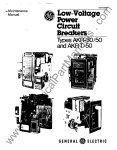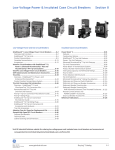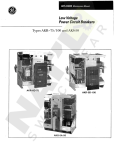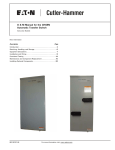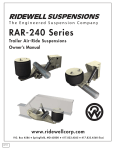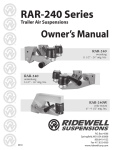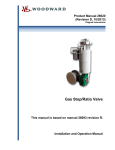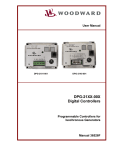Download GE AK-50 User's Manual
Transcript
g DEH–40028A Installation Instructions ProTrip™ Conversion Kits For GE Types AK-50, AKU-50, AKS-50, AKT-50, AK-75, and AK-100 Low-Voltage Power Circuit Breakers INTRODUCTION GE Conversion Kits are designed for upgrading existing GE low-voltage power circuit breakers, rather than replacing the entire breaker. The Conversion Kits include ProTrip™ Trip Units, the latest technological advance in GE trip systems. ProTrip Conversion Kits are designed and tested to conform to ANSI Standard C37.59, allowing the retrofitter to properly install the kit and acceptance test the breaker. This publication covers installation of ProTrip Conversion Kits on GE types AK-50, AKU-50, AKS-50, AKT-50, AK-75, and AK-100 low-voltage power circuit breakers. Each Conversion Kit contains all the components needed to convert from an existing GE type EC trip system. TABLE OF CONTENTS SECTION 1. GENERAL INFORMATION ....................................................................................................... 4 SECTION 2. BEFORE INSTALLATION .......................................................................................................... 4 SECTION 3. FRONT FRAME BREAKER CONVERSION Relocating and Remounting the W and X Relays.......................................................................... 5 Installing the Flux Shifter Assembly .............................................................................................. 6 Breakers with EC or Power Sensor Trip Systems ............................................................. 6 Breakers with a Side Bracket.............................................................................................. 7 AKU-50 Breakers Only ........................................................................................................ 7 Breakers with ECS or SST Trip Systems ........................................................................... 8 Installing the Trip Paddle................................................................................................................ 8 Adjusting the Flux Shifter ............................................................................................................... 8 Installing the Trip Unit Mounting Bracket...................................................................................... 9 EC or Power Sensor Trip System....................................................................................... 9 ECS or SST Trip System..................................................................................................... 9 SECTION 4. BACK FRAME CONVERSION Crossbar Modification................................................................................................................... 11 Removing the Existing Trip Devices ............................................................................................ 12 AK-50 & AKS-50 Breakers with EC or Power Sensor Trip Systems................................ 12 AK-50 & AKS-50 Breakers with SST Trip Systems.......................................................... 12 AK-75 & AK-100 Breakers with EC or Power Sensor Trip Systems ................................ 12 AK-75 & AK-100 Breakers with SST Trip Systems .......................................................... 12 Installing the Phase Sensors......................................................................................................... 13 AK-50 & AKS-50 Breakers................................................................................................. 13 AK-75 & AK-100 Breakers ................................................................................................. 14 SECTION 5. INSTALLING THE TRIP UNIT Configuring the Trip Unit.............................................................................................................. 15 SECTION 6 FOUR-WIRE GROUND FAULT OPTION Installing the Fourth-Wire Disconnect.......................................................................................... 16 AK-50 & AKS-50 Stationary Breakers............................................................................... 16 AK-50 & AKS-50 Draw-Out Breakers................................................................................ 17 AK-75 & AK-100 Draw-Out Breakers ................................................................................ 17 Installing the Neutral Sensor ........................................................................................................ 19 SECTION 7. EQUIPMENT CONVERSION Installing Mounting Brackets ........................................................................................................ 21 SECTION 8. TESTING AND TROUBLE-SHOOTING Testing ........................................................................................................................................... 23 Trouble-Shooting .......................................................................................................................... 23 Nuisance Tripping on Ground Fault-Equipped Breakers ................................................ 23 APPENDIX – DRILL TEMPLATES Appendix 1. Drill Template for Flux Shifter Mounting ................................................................ 27 Appendix 2. Drill Template for Trip Unit Mounting..................................................................... 29 Appendix 3. Drill Template for Flux Shifter Mounting ................................................................ 29 2 LIST OF FIGURES 1. Relocation and remounting of the W and X relays................................................................................. 5 2. New X and W relay mounting brackets................................................................................................... 5 3. Flux shifter assembly. .............................................................................................................................. 6 4. Pattern for flux shifter mounting holes in the side frame ...................................................................... 6 5. Flux shifter assembly mounted to the side frame. ................................................................................. 6 6. Location of new hole in the flux shifter base.......................................................................................... 7 7. Locations of new holes for mounting the OFLO terminal block. ........................................................... 7 8. Existing trip paddles to be removed. ...................................................................................................... 8 9. Installing the new trip paddle. ................................................................................................................. 8 10. Adjusting the flux shifter. ........................................................................................................................ 8 11. Mounting hole drill pattern for the trip unit mounting plate. ................................................................ 9 12. Trip unit mounting plate attached to the breaker front channel. ........................................................... 9 13. Trip unit mounting bracket attached to the mounting plate. ............................................................... 10 14. Actuator bracket attached to the left pole link. ..................................................................................... 11 15. Drill pattern for actuator bracket mounting holes. ............................................................................... 11 16. Existing EC trip devices before removal. .............................................................................................. 12 17. Removal of EC trip devices.................................................................................................................... 12 18. Parts provided for CT installation per pole. .......................................................................................... 13 19. CT post mounted in the breaker back frame......................................................................................... 13 20. CT installation completed.. .................................................................................................................... 13 21. Phase sensor installation on AK-75 & AK-100 breakers........................................................................ 14 22. Attaching the trip unit to the mounting plate ....................................................................................... 15 23. Trip unit mounted on the breaker. ........................................................................................................ 15 24. Fourth-wire terminal board installation on AK-50 & AKS-50 stationary breakers............................... 16 25. Fourth-wire disconnect installed on AK-50 & AKS-50 draw-out breakers. .......................................... 17 26. Fourth-wire disconnect assembly for AKD-5 or AKD-6 equipment...................................................... 17 27. Fourth-wire disconnect assembly for AKD equipment......................................................................... 17 28. K-75 & AK-100 back frame conversion. ................................................................................................. 18 29. Outline of the neutral sensor for AK-50 breakers.................................................................................. 19 30. Outline of the neutral sensor for AK-75 and AK-100 breakers.............................................................. 20 31. AK-50 & AKS-50 fourth-wire disconnect for AKD. ................................................................................ 21 32. AK-75 & AK-100 fourth-wire disconnect for AKD-5 & AKD-6. .............................................................. 21 33. AK-100 fourth-wire disconnect for AKD. ............................................................................................... 21 34. AK-50 & AKS-50 fourth-wire disconnect for AKD. ................................................................................ 22 35. Fourth-wire disconnect for AKD-5 & AKD-6. ......................................................................................... 22 36. Cabling diagram for ProTrip™ trip units with ground fault on four-wire loads. ................................ 25 3 SECTION 1. GENERAL INFORMATION SECTION 2. BEFORE INSTALLATION GE Conversion Kit installation is straightforward, but does require careful workmanship and attention to these instructions. Familiarity with the breaker is highly desirable. The general approach is to first remove the existing trip devices from the breaker, then install the ProTrip components. Following this procedure, the converted breaker is performance tested before it is returned to service. Before starting any work, turn off and lock out all power sources leading to the breaker, both primary and secondary. Remove the breaker to a clean, welllighted work area. WARNING: Low-voltage power circuit breakers use high-speed, stored-energy spring operating mechanisms. The breakers and their enclosures contain interlocks and safety features intended to provide safe, proper operating sequences. For maximum personnel protection during installation, operation, and maintenance of these breakers, the following procedures must be followed. Failure to follow these procedures may result in personal injury or property damage. The majority of trip unit kit installations do not require any customized assembly work. However, some conversions may involve unusual mounting conditions or accessory combinations that require minor modifications and/or relocation of components. In most instances, this supplementary work can be done on site. • Only qualified persons, as defined in the National Electrical Code, who are familiar with the installation and maintenance of low-voltage power circuit breakers and switchgear assemblies, should perform any work on these breakers. • Completely read and understand all instructions before attempting any breaker installation, operation, maintenance, or modification. • Turn off and lock out the power source feeding the breaker before attempting any installation, maintenance, or modification. Follow all lockout and tag-out rules of the National Electrical Code and all other applicable codes. • Do not work on a closed breaker or a breaker with the closing springs charged. Trip an OPEN breaker and be sure the stored-energy springs are discharged, thus removing the possibility that the breaker may trip OPEN or the closing springs discharge and cause injury. • Trip the breaker OPEN, then remove the breaker to a well-lighted work area before beginning work. • Do not perform any maintenance that includes breaker charging, closing, tripping, or any other function that could cause significant movement of a draw-out breaker while it is on the draw-out extension rails. • Do not leave the breaker in an intermediate position in the switchgear compartment. Always leave it in the CONNECTED, TEST, or DISCONNECTED position. Failure to do so could lead to improper positioning of the breaker and flashback. In preparation for the conversion, the installer should verify that the appropriate current sensors and trip unit have been furnished. Whenever a ProTrip kit is installed on a breaker with a four-wire system, an associated neutral sensor (CT) is required for separate mounting in the equipment. Ensure that retrofitted breakers are applied within their shortcircuit ratings. For example, if the previous trip unit provided long-time instantaneous protection, the short-time rating of the ProTrip Trip Unit will govern the application. As a service-related consideration, the installation of a ProTrip kit provides an excellent opportunity to perform normal maintenance on the breaker, particularly when the front and back frames are separated. Such procedures are described in the installation and maintenance manuals supplied with the breaker and equipment. 4 SECTION 3. FRONT FRAME BREAKER CONVERSION Front frame conversion consists of the following steps: 1. Separation of the front and back breaker frames for AK-50, AKU-50, AKS-50, and AKT-50 breakers. (Frame separation is not necessary for AK-75 and AK-100 breakers.) Refer to the appropriate installation and maintenance manuals supplied with the breakers and equipment for instructions on frame separation. Copies of these publications may be obtained from your local GE sales office. 2. Relocation and remounting the W and X relays on AK-50, AK-75, and AK-100 electrically operated breakers with EC trip devices. 3. Installation of the flux shifter assembly and trip paddle. 4. Installation of the trip unit mounting bracket. 5. Installation of the trip unit wiring harness. Relocating and Remounting the W and X Relays This step is necessary on electrically operated breakers with EC trip devices. Figure 1 illustrates this process. Figure 2 shows the new mounting brackets supplied with the kit. 1. Remove the W relay and install the mounting bracket supplied with the conversion kit to the upper left side of the frame 2. Remove the X relay and its mounting bracket. Use the new bracket supplied with the conversion kit to remount the X relay in its existing position. Figure 1. Relocation and remounting of the W and X relays. W Relay X Relay Figure 2. New X and W relay mounting brackets. 5 Installing the Flux Shifter Assembly The installation procedure for the flux shifter assembly, illustrated in Figure 3, varies depending on the type of breaker and existing trip device. In some cases, mounting holes must be added, terminal blocks relocated, or breaker side rails removed. Breakers with EC or Power Sensor Trip Systems 1. Drill the flux shifter mounting holes in the left side of the breaker frame. The mounting hole pattern is illustrated in Figure 4. A full-size template is provided in the Appendix. 2. Mount the new flux shifter to the inside of the side frame with the three screws, lock washers, flat washers, and nuts supplied, as shown in Figure 5. Insert the screws from the outside of the side frame. Figure 4. Pattern for flux shifter mounting holes in the side frame. Mounting Screws Flux Shifter Assembly Figure 5. Flux shifter assembly mounted to the side frame. Figure 3. Flux shifter assembly. 6 Breakers with a Side Bracket 1. Drill a 3 4” diameter hole into the flux shifter assembly mounting base to provide the necessary clearance for the bracket. The location of the new hole is shown in Figure 6. 2. Remove the side bracket from the frame and drill the holes according to the pattern in Figure 4. A full-size template is provided in the Appendix. After the holes are drilled, return the side bracket to its original location. 3. Mount the new flux shifter to the inside of the side frame with the three screws, lock washers, flat washers, and nuts supplied, as shown in Figure 5. The upper two screws are inserted from the outside of the frame, while the lower screw must be inserted from the inside. Figure 6. Location of new hole in the flux shifter base. AKU-50 Breakers Only For easier installation of the new flux shifter assembly on AKU-50 breakers, the open-fuse lockout (OFLO) may be removed from the breaker. 1. Remove the three bolts attaching the OFLO to the base of the breaker. 2. The OFLO terminal block must be relocated on the upper left side of the breaker. Some parts and tool, not provided with the kit, are necessary for this task: • Six strips of 14 AWG wire • Wire splice • 12 butt splices • Wire labels • Drill and size F bit • 5/16-18 tap • Flathead screw driver • Two 5/16-18 bolts and lock washers 3. Drill and tap two holes for the 5/16-18 bolts. Figure 7 shows the hole locations. 4. Remove the three bolts securing the OFLO to the breaker and lift off the OFLO device. 5. Remove the wires that connect the OFLO device to the terminal block. Figure 7. Locations of new holes for mounting the OFLO terminal block. 6. Cut the wires that connect to the coils where they join and label the wires. Attach butt splices to all twelve open ends. 7. Connect the strands of wire to the OFLO. Mount the terminal block in its new location. DO NOT complete the wire connections until the flux shifter is installed. 8. Install the new flux shifter assembly as described above and shown in Figure 5. 9. Connect the cables attached to the terminal block and tie them together. 7 Breakers with ECS or SST Trip Systems 1. Remove the ECS or SST trip unit. 2. Remove the existing flux shifter device and the trip unit control harness. 3. Install the new flux shifter assembly as described above and shown in Figure 5. Installing the Trip Paddle For breakers equipped with an ECS or SST trip system, the existing trip paddle is used with the new flux shifter. Trip Paddles For all other breakers, the existing trip paddles must be removed and the new trip paddle installed as follows: 1. Remove and discard the three trip paddles on the trip actuator bar, as shown in Figure 8. 2. Assemble the trip paddle and the threaded back plate by inserting two of the 10-32 x 3 4" screws and lock washers provided along the top edge. 3. Slip the trip paddle over the trip actuator bar approximately one inch from the side frame, as shown in Figure 9. Insert the remaining 10-32 x 3 4" screw and tighten the other screws to secure the trip paddle in place. Figure 8. Existing trip paddles to be removed. 1” Adjusting the Flux Shifter After the flux shifter and trip paddle are installed and the breaker frames are reassembled, the following adjustments must be made. Trip Paddle 1. With the breaker OPEN and the mechanism charged, set the gap between the trip paddle and the end of the flux shifter rod at 0.10 inch, as shown in Figure 10. Use a 0.10-inch diameter rod. Set the adjuster end of the trip rod and lock it in place with the jam nut. Note that removal of the buffer stud will make the trip paddle easier to install and adjust. Figure 9. Installing the new trip paddle. 2. As the crossbar travels between the breaker CLOSED and OPEN positions, the tang of the actuator bracket must clear the buffer stud. If there is insufficient clearance, loosen the two mounting screws and rotate the bracket clockwise to take up mounting hole slack. Retighten the screws. 3. Optional Test – The flux shifter may be tested by closing the breaker and applying a 9 Vdc power source to the flux shifter leads (the red wire is positive). The breaker should trip. Figure 10. Adjusting the flux shifter. 8 Installing the Trip Unit Mounting Bracket The new ProTrip trip unit mounts to the left side of the front channel. A mounting bracket is shock-mounted to a plate that is assembled to the front channel. EC or Power Sensor Trip System 1. The holes for the new mounting plate may have to be added to the front channel. The drill pattern is shown in Figure 11, with a full-size template in the Appendix. Tap the holes for 1/4-20 screws. 2. Attach the new mounting plate, as shown in Figure 12, with two short 1/4-20 screws and lock washers on the top and the single long 1/4-20 screw and lock washer on the bottom. Be sure to insert the spacer between the mounting plate and the breaker channel, as shown. 3. Attach the trip unit mounting bracket to the plate with two screws, lock washers, and flat washers, as shown in Figure 13. ECS or SST Trip System Figure 11. Mounting hole drill pattern for the trip unit mounting plate. Remove the existing mounting plate and bracket. Install the new mounting plate and bracket, using the holes closest to the front of the breaker, as described in steps 2 and 3 above. If the manual indicator assembly busing on AK-50 manual breakers interferes with the mounting bracket installation, then the bracket must be modified. Cut off a 3/4 x 11/2 inch section from the right front of the plate to provide clearance. Figure 12. Trip unit mounting plate attached to the breaker front channel. 9 Figure 13. Trip unit mounting bracket attached to the mounting plate. 10 SECTION 4. BACK FRAME CONVERSION The back frame conversion consists of the following operations: Left Pole Link 1. Modification of the crossbar assembly for the flux shifter installation. 2. Removal of the existing trip devices. 3. Installation of the phase sensors. 4. Installation of the back frame harness. Actuator Bracket Crossbar Modification The flux shifter reset linkage is driven by the actuator bracket, as shown in Figure 3. The actuator bracket must be assembled to the left side link of the left pole, as shown in Figure 14. If the actuator bracket mounting holes are not in the left side link, the holes must be added. Drill and tap two 5/16-18 holes using the pattern in Figure 15. A full-size template is provided in the Appendix. Figure 14. Actuator bracket attached to the left pole link. Figure 15. Drill pattern for actuator bracket mounting holes. 11 Removing the Existing Trip Devices Coil Mounting Bolts AK-50 & AKS-50 Breakers with EC or Power Sensor Trip Systems 1. Remove and discard the two screws at the base of each trip device, as shown in Figure 16. Discard the metal mounting brackets. 2. Remove and discard the small Philips-head screw at the top of each trip device. 3. Remove and discard the four 5 16" Allen-head bolts securing each trip coil. The coil can then be lifted off and removed. Figure 17 shows one trip completely removed, one with the cover removed, and one still in place. Cover Screws and Clamps Figure 16. Existing EC trip devices before removal. AK-50 & AKS-50 Breakers with SST Trip Systems Remove the existing SST phase sensors in preparation for installing the new sensors. AK-75 & AK-100 Breakers with EC or Power Sensor Trip Systems Remove the existing trip devices and harnesses and discard. AK-75 & AK-100 Breakers with SST Trip Systems The new ProTrip phase sensors are visually identical to the SST sensors. Remove the existing sensors and discard. Figure 17. Removal of EC trip devices. 12 Installing the Phase Sensors AK-50 & AKS-50 Breakers Figure 18 shows the parts provided for assembly of the CT on each pole. 1. Mount the new copper CT post to the back frame with the two 3 8-16 x 11 2" bolts, flat washers, and lock washers provided, as shown in Figure 19. 2. Fasten the three small insulated wire fasteners to the back frame with the 1 4-20 x 13 4" screws provided, as shown in Figure 20. One fastener is mounted under each CT. 3. Place a CT over each copper post, first applying a small amount of RTV or similar adhesive to prevent the CTs from rotating. 4. Mount the top copper bus over each CT and secure with the 1 2-13 x 11 2" Allen-head bolts, lock washers, and flat washers provided. 5. Insert two 3 8-16 x 11 2" bolts, lock washers, and flat washers through each top copper bus into the contact arm assembly. 6. Tighten the 3 8-16 bolts to 200 in-lb and the 1 213 bolts to 300 in-lb. Figure 18. Parts provided for CT installation for one pole. WARNING: Step 6 ensures critical electrical integrity connections. The designated bolts must be correctly tightened for proper operation. Failure to tighten these bolts properly will cause a breaker failure, resulting in property damage and/or personal injury. Figure 19. CT post mounted in the breaker back frame. Top Copper Bus 1 2-13 Bolt 3 8-16 Bolts Wire Harness Figure 20. CT installation completed.. 13 Wire Fastener AK-75 & AK-100 Breakers 1. The ProTrip phase sensors mount on the upper breaker studs, as shown in Figure 21. The sensors held on the stud with locking rings. Leave enough of the stud exposed for the primary fingers to engage. Engage the sensor’s antiturn lugs with the notch in the locking ring. Before tightening the locking rings, position each sensor so that its leads exit between the pole bases, as shown. 2. Mount the three sensor terminal boards to the rear of the back frame using the hardware provided. 3. Form each sensor’s leads downward between the pole bases. Figure 21. Phase sensor installation on AK-75 & AK-100 breakers. 14 SECTION 5. INSTALLING THE TRIP UNIT 1. Remove the large screw from the rear of the trip unit. Place the trip unit in position on the mounting plate, with the 50-pin connector aligned with the opening in the plate. Secure with the large screw, as shown in Figure 22. 2. Insert the 50-pin female connector on the wiring harness into the trip unit connector through the rear of the mounting plate. Secure to the mounting plate with the two small screws provided, as shown in Figure 22. 3. Place the trip unit and mounting plate in position on the support bracket mounted on the breaker. Secure with the three screws, lock washers, and flat washers through the holes in the mounting plate into the tapped holes in the bracket, as shown in Figure 23. Trip Unit Mounting Plate Trip Unit Trip Unit Mounting Screw Wiring Harness Connector Configuring the Trip Unit See DEH-40034 for detailed instructions for setting up ProTrip trip units. Figure 22. Attaching the trip unit to the mounting plate. Figure 23. Trip unit mounted on the breaker. 15 SECTION 6 FOUR-WIRE GROUND FAULT OPTION The ground fault option for four-wire installations requires the installation of an additional current sensor on the neutral bus in the equipment. The sensor is connected to the trip unit through the connector provided in the wiring harness. Installing the Fourth-Wire Disconnect AK-50 & AKS-50 Stationary Breakers The fourth-wire disconnect for stationary breakers consists of a terminal board mounted to the lower front channel, as shown in Figure 24. • If the terminal board is already present on the breaker, just replace the control harness. Maintain the following color code: white wire to common, black wire to the tap. • If the terminal board must be added, mount it as shown in Figure 24. The mounting holes may have to be added to the front channel. Figure 24. Fourth-wire terminal board installation on AK-50 & AKS-50 stationary breakers. 16 AK-50 & AKS-50 Draw-Out Breakers The fourth-wire disconnect for AK-50 and AKS-50 draw-out breakers mounts to the lower back frame, as shown in Figure 25. • If the terminal board is already present on the breaker, just replace the control harness. Maintain the following color code: white wire to common, black wire to the tap. • If the disconnect must be added, mount it as shown in Figure 25. AK-75 & AK-100 Draw-Out Breakers Figure 25. Fourth-wire disconnect installed on AK-50 & AKS-50 draw-out breakers. There are two fourth-wire disconnect designs used with these breakers. One design is used on breakers for GE type AKD switchgear, while the other applies to breakers for GE types AKD-5 and AKD-6 equipment. The only difference is the bracket used for mounting the disconnect to the breaker. Figures 26 and 27 show these two designs. The conversion kit contains an assembled, ready-toinstall mounting block and bracket for AKD-5 and AKD-6 installation, plus an addition bracket only for type AKD equipment installations. For AKD equipment, remove the bracket from the assembled disconnect and replace it with the AKD bracket. The fourth-wire disconnect for AK-75 and AK-100 draw-out breakers mounts to the lower back frame as shown in Figure 28. • If the terminal board is already present on the breaker, just replace the control harness. Maintain the following color code: white wire to common, black wire to the tap. • If the disconnect must be added, mount it as shown in Figure 28. Figure 26. Fourth-wire disconnect assembly for AKD-5 or AKD-6 equipment. Figure 27. Fourth-wire disconnect assembly for AKD equipment. 17 Figure 28. AK-75 & AK-100 back frame conversion. 18 Installing the Neutral Sensor The neutral sensor is an electrical duplicate of the phase sensor, including the taps. Therefore, when taps (if provided) are changed on the phase sensors, the taps on the neutral sensor must be similarly changed. For kits with fixed phase sensors, be sure to use the corresponding tap on the neutral sensor. Mount the neutral sensor on the outgoing neutral lead, normally in the equipment bus or cable compartment. Figure 29 shows mounting details for the neutral sensor for AK-50 breakers, while Figure 30 covers AK-75 and AK-100 breakers. Figure 29. Outline of the neutral sensor for AK-50 breakers. 19 Figure 30. Outline of the neutral sensor for AK-75 and AK-100 breakers 20 SECTION 7. EQUIPMENT CONVERSION Installing Mounting Brackets The equipment compartment contains the mating portions of the fourth-wire disconnect and the neutral sensor. The same disconnect assembly is used for types AKD, AKD-5, and AKD-6 switchgear. Mounting brackets for AKD, AKD-5, AKD-6, and AKD-8 switchgear applications are included in the conversion kit. Figures 31, 32, 33, 34, and 35 are mounting diagrams for the various applications. Table 1 is a key to the numbers used in these figures to indicate various hardware items. Figure 31. AK-50 & AKS-50 fourth-wire disconnect for AKD. Legend Description 225 226 229 230 231 232 233 235 236 237 238 239 Breaker portion of fourth-wire disconnect Equipment portion of fourth-wire disconnect Mounting bracket for AK-100 for AKD compartments 10-32 x 1.375 inch mounting screw Insulation #10 lock washer #10 flat washer 1/8-20 flat washer 1/8-20 lock washer 1/4-20 nut 1/4-20 x 1.25 inch mounting screw Bracket Figure 32. AK-75 & AK-100 fourth-wire disconnect for AKD-5 & AKD-6. Table 1. Legend for number symbols appearing in Figures 31– 35. Figure 33. AK-100 fourth-wire disconnect for AKD. 21 Figure 34. AK-50 & AKS-50 fourth-wire disconnect for AKD. Figure 35. Fourth-wire disconnect for AKD-5 & AKD-6. 22 SECTION 8. TESTING AND TROUBLESHOOTING ter or millivolt tester. If the resistance differs considerably from phase to phase, the electrical connections may not be properly tightened or it could also indicate improper contact wipe. 4. To verify that the breaker has been properly retrofitted, perform a primary injection test on each phase. This test will check the CTs, bus, wiring harness, flux shifter, and trip unit as a complete system. a. A high-current, low-voltage power supply should be connected across each line and load terminal to simulate an overcurrent fault. b. Set the long-time trip at 0.5 to minimize the breaker stress. c. When ground fault is installed, the test can be performed by wiring two adjacent poles in series or by using the GE Digital Test Kit, cat. no. TVRMS2. This will prevent the breaker from tripping because of an unbalanced current flow. WARNING: Do not change taps on the current sensors or adjust the trip unit settings while the breaker is carrying current. Failure to adhere to these instructions will void all warranties. Testing Before installing a converted breaker back into service, perform the following steps: 1. Verify that the trip unit is securely installed by performing a continuity test on the CT wiring and the trip unit. a. Disconnect the black CT wires at each phase sensor. b. Check for continuity with a continuity tester or VOM from the white lead of the phase A CT to the white lead of the phase B CT. c. Repeat this continuity test for the white leads of the phase A and phase C CTs. d. Measure the resistance across each phase sensor and compare the values measured to the values listed in Table 1. e. Reconnect the black CT leads to all of the phase sensors. Ensure that this is done before continuing with performance testing of the breaker. CAUTION: Do not attempt to use GE Test Kit cat. no. TVTS1 or TVRMS on this trip unit. Trouble-Shooting When malfunctioning is suspected, first examine the breaker and its power system for abnormal conditions such as the following: • The breaker is not tripping in response to overcurrent conditions or incipient ground faults. • The breaker is remaining in a trip-free state because of mechanical interference along its trip shaft. • The shunt trip (if present) is activating improperly. CAUTION: In addition to the continuity test described in Step 1 and before performance testing of the converted breaker, each phase of the breaker should be primary injected with a current level of about 10%, but no more than 20%, of the CT rating. During the application of test current, activate the trip unit screen by depressing the battery button on the trip unit face and check that the test current is displayed on the screen for each phase tested. If the trip unit fails to display the test current, stop the test immediately and verify the installation of the trip unit and wire harness before proceeding with any additional testing. Nuisance Tripping on Ground Fault-Equipped Breakers When nuisance tripping occurs on breakers equipped with ground fault trip, a probable cause is the existence of a false ground signal. Each phase sensor is connected to summing circuitry in the trip unit. Under no-fault conditions on three-wire load circuits, the currents add to zero and no ground signal is developed. This current sum is zero only if all three sensors have the same electrical characteristics. If one sensor differs from the others (such as by a different rating or wrong tap setting), the circuitry can produce an output sufficient to trip the breaker. Similarly, a discontinuity between any sensor and the trip unit can cause a false trip signal. WARNING: If the converted breaker is energized or tested by primary injection with a sufficiently high test current with a loose or open circuit between the CTs and the trip unit, damage will occur to the trip unit, wire harness, 36-pin trip unit connector, and CTs. Failure to adhere to these instructions will void all warranties. The sensors and their connections should be closely examined if nuisance tripping is encountered on any breaker whose ProTrip trip unit has previously demonstrated satisfactory performance. After dis- 2. Check the insulation on the primary circuit with a 1,000-volt Meggar. 3. Measure the resistance across the line and load terminals for each phase using a micro-ohmme23 connecting the breaker from all power sources, perform the following procedure: Breaker 1. Check that all phase sensors are the same type (current range). 2. Verify that the tap settings on all three phase sensors are identical. 3. Verify that the wiring harness connections to the sensors have the proper polarity (white lead to common, black lead to tap), as shown in the cabling diagram in Figure 36. 4. On ground fault breakers serving four-wire loads, check that the neutral sensor is properly connected, as indicated in Figure 36. In particular, check the following: a. Verify that the neutral sensor has the same rating and tap setting as the phase sensors. b. Verify continuity between the neutral sensor and its equipment-mounted secondary disconnect block. Also check for continuity from the breaker-mounted neutral secondary disconnect block through to the trip unit wiring harness connector. c. If the breaker’s lower studs connect to the power source, then the neutral sensor must have its load end connected to the source. d. Verify that the neutral conductor is carrying only the neutral current associated with the breaker’s load current (the neutral is not shared with other loads). 5. If the preceding steps fail to identify the problem, then measure the sensor resistances. The appropriate values are listed in Table 2. Since the phase and neutral sensors are electrically identical, their resistances should agree closely. AK-50 AKS-50 AK-75 AK-100 CT Rating, A Resistance, ohms 300 400 600 800 1200 1600 1200 1600 2000 3000 1600 2000 3000 4000 20–24 27–32 42–50 58–68 93–109 130–154 20–24 28–34 37–44 61–72 36–43 47–55 75–88 108–127 Table 2. CT resistance values. 24 Figure 36. Cabling diagram for ProTrip™ trip units with ground fault on four-wire loads. 25 APPENDIX – DRILL TEMPLATES Appendix 1. Drill Template for Flux Shifter Mounting 27 Appendix 2. Drill Template for Trip Unit Mounting Appendix 3. Drill Template for Flux Shifter Mounting 29 These instructions do not cover all details or variations in equipment nor do they provide for every possible contingency that may be met in connection with installation, operation, or maintenance. Should further information be desired or should particular problems arise that are not covered sufficiently for the purchaser’s purposes, the matter should be referred to the GE Company. g GE Industrial Systems General Electric Company 41 Woodford Ave., Plainville, CT 06062 DEH40028 R02 1198 © 1998 General Electric Company
































